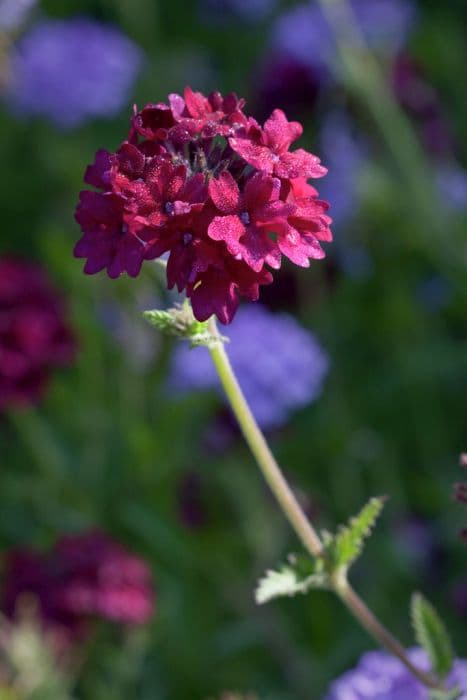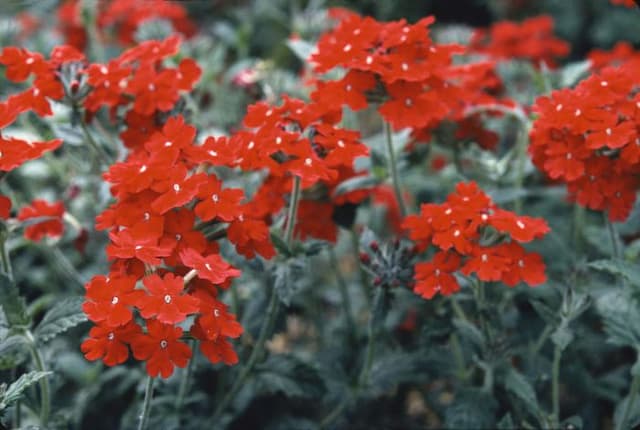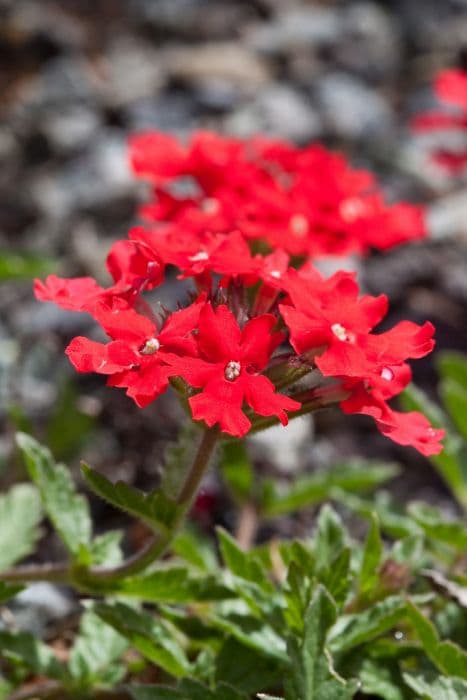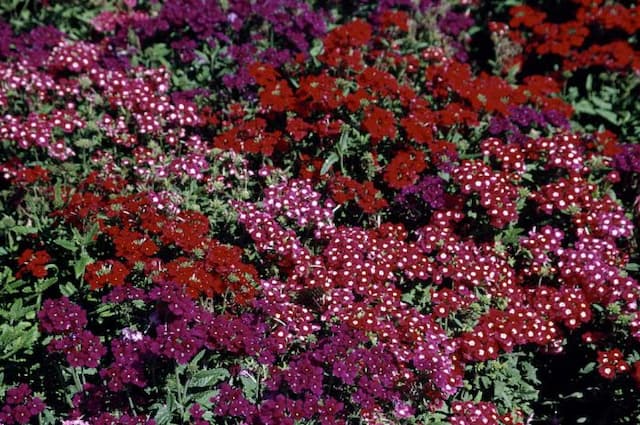Canadian Vervain Glandularia canadensis 'Toronto'

ABOUT
The 'Toronto' is a flowering perennial known for its vibrant and showy blooms. The flowers are typically a rich purple or violet color, sometimes with white centers and a tubular shape, which give a lovely splash of color in gardens. They are clustered together at the tips of the stems, creating dense, rounded clusters that add to the plant's visual appeal. The foliage of the 'Toronto' is equally attractive, comprised of small, lance-shaped leaves that are sometimes slightly toothed. These leaves are arranged on the stem in a way that they form a lush, green background that makes the purple flowers stand out even more prominently. The overall structure of the 'Toronto' is spreading and mounding, creating a full-bodied appearance that works well as ground cover or when planted in masses. The texture added by both its leaves and flowers can provide a soft, yet lively character to garden spaces. Its long blooming period and adaptability to a wide range of growing conditions make it a popular choice for gardeners looking to add lasting color and interest to their landscapes.
About this plant
 Names
NamesFamily
Verbenaceae
Synonyms
Canada Vervain, Rose Vervain, Clump Verbena, Garden Verbena, Rose Mock Vervain
Common names
Verbena canadensis 'Toronto', Verbena canadensis var. canadensis, Glandularia canadensis var. canadensis, Glandularia canadensis.
 Toxicity
ToxicityTo humans
The plant known as Toronto verbena (Glandularia canadensis 'Toronto') is not commonly listed as a toxic plant to humans. This means there is limited or no significant toxic risk noted for general human interactions or ingestion. However, as with any plant, individual allergies or sensitivities could potentially cause mild reactions. It is always wise to exercise caution and avoid ingesting plants that are not specifically known to be edible.
To pets
Toronto verbena (Glandularia canadensis 'Toronto') is also not widely recognized as a toxic plant to pets. There is no substantial evidence suggesting that this plant is poisonous to dogs, cats, or other domestic animals. As with humans, there should still be caution as individual animals might experience adverse reactions if they are sensitive or allergic to the plant. If a pet ingests a significant amount of Toronto verbena and shows any unusual symptoms, it is best to consult a veterinarian.
 Characteristics
CharacteristicsLife cycle
Perennials
Foliage type
Deciduous
Color of leaves
Green
Flower color
Pink
Height
0.5 feet (15 cm)
Spread
1.5 feet (45 cm)
Plant type
Herb
Hardiness zones
5
Native area
North America
Benefits
 General Benefits
General Benefits- Attracts Pollinators: Glandularia canadensis 'Toronto', commonly known as Canadian vervain, is known to attract butterflies and other beneficial insects, supporting local biodiversity.
- Low Maintenance: Canadian vervain is a hardy plant that generally requires minimal care once established, making it suitable for novice gardeners or those with limited gardening time.
- Drought Tolerance: Once established, Canadian vervain has good drought tolerance, making it a wise choice for water-conservation landscapes and xeriscaping.
- Aesthetic Appeal: With its bright and showy flowers, Canadian vervain adds vibrant color to gardens and landscapes from late spring to early fall.
- Garden Filler: This plant tends to spread and can fill in gaps in garden beds, providing a lush, full appearance in the landscape.
- Erosion Control: The spreading habit and root system of Canadian vervain can help stabilize soil and reduce erosion on slopes or in areas prone to soil loss.
- Rapid Growth: Canadian vervain exhibits fast growth, allowing for quick establishment and coverage in garden settings.
- Adaptable: This species is adaptable to a range of soil conditions, although it prefers well-drained soils. It can thrive in various environments, from full sun to partial shade.
- Habitat Restoration: Canadian vervain can be used in native planting schemes and habitat restoration projects to help recreate natural ecosystems.
- Seasonal Interest: Arraying in hues of purple, pink, or blue, the Canadian vervain offers seasonal interest and can be used to create time-specific focal points in the landscape.
 Medical Properties
Medical PropertiesThis plant is not used for medical purposes.
 Air-purifying Qualities
Air-purifying QualitiesThis plant is not specifically known for air purifying qualities.
 Other Uses
Other Uses- Wildlife Attraction: Glandularia canadensis 'Toronto,' or Canadian vervain, can serve as a nectar source to attract butterflies, hummingbirds, and other pollinators to a garden.
- Erosion Control: Due to its hardy and spreading nature, Canadian vervain can be used on slopes and banks to help control erosion and stabilize the soil.
- Educational Use: Botany students and educators can utilize Canadian vervain to study plant structure, pollination mechanisms, and the life cycle of perennial plants.
- Ground Cover: Canadian vervain can be used as a dense ground cover in garden beds, providing a colorful carpet that suppresses weeds and reduces garden maintenance.
- Dye Production: The flowers of Canadian vervain can potentially be used to create natural dyes for fabrics, though it's not a commonly known use.
- Landscaping Themes: In themed gardens, such as a 'North American native' garden, Canadian vervain adds authenticity and color diversity.
- Garden Borders: Canadian vervain's spreading habit and vibrant flowers make it ideal for creating defined edges along garden paths and borders.
- Habitat Restoration: Canadian vervain can be used in restoration projects, as it is native to certain regions and can help restore natural plant communities.
- Photographic Subject: Gardeners and photographers may use Canadian vervain as a subject for nature photography due to its bright flowers and attractiveness to wildlife.
- Artistic Inspiration: The vibrant colors and forms of Canadian vervain can provide inspiration for artists and be used as a model for drawings, paintings, and other forms of art.
Interesting Facts
 Feng Shui
Feng ShuiThe Moss Verbena is not used in Feng Shui practice.
 Zodiac Sign Compitability
Zodiac Sign CompitabilityThe Moss Verbena is not used in astrology practice.
 Plant Symbolism
Plant Symbolism- Harmony: Garden Verbena, which Glandularia canadensis 'Toronto' is commonly known as, generally symbolizes harmony, bringing a sense of peace and cohesiveness to a garden or to the person it is given to.
- Healing: Historically, Verbena has been associated with healing and has been used in traditional medicine, signifying a wish for recovery or good health.
- Sensibility: The plant is sometimes connected to sensibility and level-headedness, possibly stemming from its balanced growth pattern and attractive yet not overbearing presence.
- Attraction: The bright and vibrant flowers of Garden Verbena can symbolize attraction or magnetism, reflecting how the plant draws in both humans and pollinators alike.
- Enchantment: With its delicate blossoms and lovely fragrance, Garden Verbena can also represent a sense of enchantment or the idea of being bewitched by someone’s charm.
 Water
WaterThe Canada Vervain should be watered regularly to maintain evenly moist soil, especially during the warmer seasons. Water deeply once or twice a week, allowing the soil to slightly dry between waterings. During prolonged dry spells, you may need to increase watering frequency. Each watering session should consist of enough water to soak the soil to a depth of about 6 inches. Be cautious of over-watering; ensure the plant is in well-draining soil to prevent root rot.
 Light
LightCanada Vervain fares best in full sunlight to light partial shade. The ideal location would receive at least 6 to 8 hours of direct sunlight each day, which promotes healthy growth and abundant flowering. Avoid deep shade as it can result in leggy plants with fewer flowers.
 Temperature
TemperatureCanada Vervain thrives in a temperature range between 60°F and 85°F. It can tolerate a minimum temperature of around 50°F. However, temperatures dipping below this can harm the plant. Always protect the plant from frost, which can be detrimental.
 Pruning
PruningPruning Canada Vervain is beneficial for promoting bushier growth and more blooms. Prune lightly throughout the growing season to remove spent blooms and encourage new ones. The best time to perform a more significant pruning is in early spring to shape the plant and prepare it for new growth.
 Cleaning
CleaningAs needed
 Soil
SoilCanadian Vervain 'Toronto' thrives best in a well-draining soil mix with a pH ranging from 6.0 to 7.5. An ideal mix would be equal parts of loam, sand, and peat to ensure proper drainage and aeration. Regular garden soil can also be amended with organic material and perlite to improve its structure and fertility for this plant.
 Repotting
RepottingCanadian Vervain 'Toronto' typically doesn't require frequent repotting and can be done every 2-3 years, or when it outgrows its current container. Ensure that the new pot has ample drainage holes and only increase the pot size gradually to prevent stress to the plant.
 Humidity & Misting
Humidity & MistingCanadian Vervain 'Toronto' is tolerant of a wide range of humidity levels but performs best in moderate humidity. Avoid environments that are too dry or extremely humid to maintain the health and vigor of the plant.
 Suitable locations
Suitable locationsIndoor
Place Canadian Vervain 'Toronto' near a sunny window and ensure good air circulation.
Outdoor
Plant Canadian Vervain 'Toronto' in full sun to partial shade in well-draining soil.
Hardiness zone
3-8 USDA
 Life cycle
Life cycleGlandularia canadensis 'Toronto', commonly known as Toronto Verbena, begins its life cycle as a seed that germinates in spring when the soil temperature increases. Once germinated, the seedling emerges and establishes a root system while developing its first set of true leaves. As it matures during the growing season, the plant experiences vegetative growth, producing stems and leaves, and ultimately starting to branch out. The Toronto Verbena then enters the flowering stage, typically in late spring or early summer, showcasing clusters of vibrant flowers that attract pollinators. After pollination, it sets seeds which are then dispersed by wind or wildlife, and the plant may die back if it is an annual variety or become dormant in winter if it is a perennial. Finally, if the conditions allow, the seeds will overwinter and begin a new life cycle the following spring.
 Propogation
PropogationPropogation time
Spring-Summer
The most popular method of propagating Glandularia canadensis 'Toronto', commonly known as Canadian Vervain or Toronto Verbena, is through stem cuttings. This technique is typically performed in late spring or early summer when the plant is actively growing. To propagate, choose a healthy, non-flowering stem and cut a 4 to 6-inch (approximately 10 to 15 cm) section just below a leaf node. Strip off the lower leaves and dip the cut end in rooting hormone to encourage root growth. Insert the cutting into a pot filled with moist potting mix or a mixture of perlite and peat. Cover the pot with a plastic bag or place it in a propagator to maintain humidity, and place it in indirect light. Roots usually develop within a few weeks after which the new vervain plant can be transplanted into the garden or into individual pots.
![Vervain [Donalena Lavender Grace]](/_next/image?url=https%3A%2F%2Fplants-admin.emdemapps.com%2Fimages%2Fplants%2F%2Fimages%2F604b575c837e7.png&w=640&q=75)
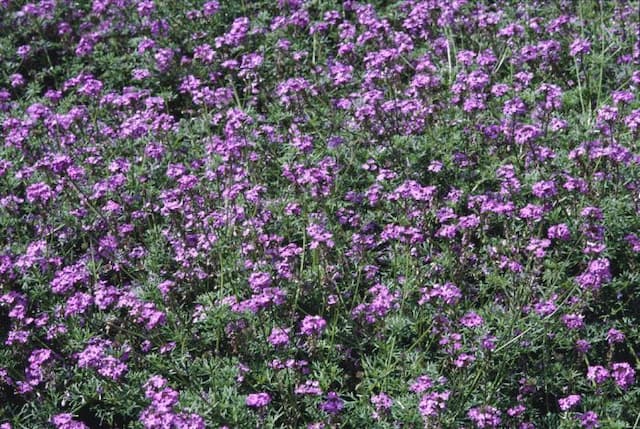
![Vervain [Endurascape Pink Bicolor]](/_next/image?url=https%3A%2F%2Fplants-admin.emdemapps.com%2Fimages%2Fplants%2F%2Fimages%2F604b594e749b0.png&w=640&q=75)
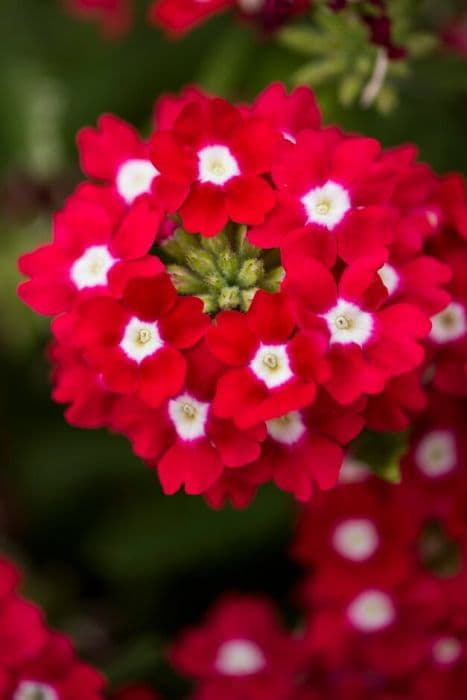
![Vervain [Seabrook's Lavender]](/_next/image?url=https%3A%2F%2Fplants-admin.emdemapps.com%2Fimages%2Fplants%2F%2Fimages%2F604b650ea9729.png&w=640&q=75)

